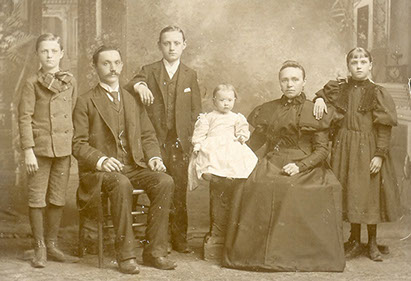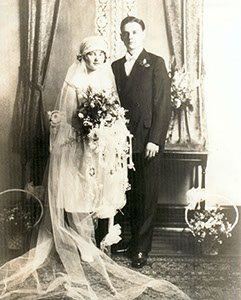

INTRODUCTION
In the late 1970s, I watched my father, Edwin Brune, and mother, Ruth (Hecht) Brune, work on genealogy. My Dad had recently retired and pursued genealogy as a hobby. My Mom had notes from her mother Alvina (Brueseke) Hecht and she began adding the data to charts that looked like family trees. A few years later, I married and became interested in gathering information on my new married name. Thus began the collection of data that led to this book.
When I started in genealogy in the 1980s, the technique for finding information was so different from today. Most of the data that I have gathered on the Brueseke family, I acquired in 1998–1999 and the past two years (2005-2006). Using a computer, the Internet, and email has enabled me to find many relatives that my Mother did not know existed. In 2005 I finished a family history book on the Hecht family, my mother’s father’s family. After that I decided to work on my mother’s mother’s family, the Bruesekes.

Bill, Henry, Fred, Louise "Lulu", Louis, and Alvina Brueseke, 1897
I used much of my vacation time from work to research records at the probate court and recorder of deeds offices in the courthouse of Franklin County, Missouri; plus cemeteries in Franklin County and St. Louis. Other research facilities have included the Scenic Regional Library, Union, Missouri; Warren County, Missouri, Courthouse and library; State Historical Society of Missouri, Columbia, Missouri; Missouri Archives, Jefferson City, Missouri; St. Louis County Library; Allen County Library, Fort Wayne, Indiana; Missouri Historical Society Library, St. Louis; St. Louis Public Library; St. Louis Genealogical Society; Zion United Church of Christ, Florissant, Missouri; St. Paul’s United Church of Christ, Marthasville, Missouri; Family History Library microfilm and of course, any database I could find on the Internet. I have written hundreds of letters and emails to relatives and organizations to gather information. Through this effort I’ve identified over 1500 Brueseke descendants. I took early retirement in December 2005 and decided to spend most of my time working on the book in 2006. Out of curiosity I kept a log of my hours on this book in 2006 and between January and
and August I have spent nearly 40 hours a week researching, corresponding with relatives, scanning photos, and writing and typing this book.
I am blessed that my late grandmother, Alvina (Brueseke) Hecht, and my mother, Ruth, were organized people. They each had extensive photo albums with nearly every picture labeled with names and dates. Some of these photos went back to the 1870s.
I have pestered relatives to write stories about their families, parents, and grandparents so I could add them to this book. I thank many of them for doing this and sharing copies of photos and other documents. It is these stories that make the people interesting and come to life and more than just “born, married, died” statistics. If I can generalize and characterize them, I would say they came from strong German stock, had a good work ethic, worked hard, and most achieved a lot in spite of humble beginnings. Some of the Bruesekes were poor, others were very frugal and struggled through the Depression years of the 1930s.
Several people have helped me extensively in gathering information for this book. In the 1990s the late Vivian (Bland) Robertson shared much information with me on the Franklin County Ernst Brueseke descendants. Glen Blesi has shared names and addresses of Franklin County people so I could contact them and he was a tremendous source of Franklin County obituaries. I thank them for their kindness. Many others including Carole (Nappier) Billingsley, Faril Bea (Schmidt) Dickens, Kathy Farrar, Dorothy Hardecke, Ruth (Hecht) Brune, Helen Oakley, Martha (Oakley) Kremer, Jane (Koelling) Parker, Vonda Mesger, Wilma (Boster) Tutterrow, Jenny (Zoeller) Blesi, Paul Rahmeier, Lynda (Brueseke) Harman wrote extensive stories and shared extensive photos and data. Others were gracious about proofing the chapters relating to their family. I’ve struggled with my lack of knowledge of the German language but Ulrike (Gründler) Pust and Norma Kraus who live in Germany have helped identify German words on documents for me.
Several years ago, I took a class on how to write your family history and that led me to start this book. I needed technological help and I thank Karen Miller for her assistance in adding the scanned photos to the Microsoft Word chapters and Ann Fleming, CG, CGL, for her advice and willingness to review the entire book.
Throughout the book, I have retained the original spelling I found in historical documents, even if it was incorrect. I have tried to list [sic] to designate the spelling is incorrect; however, the text contains the original spelling. Thus you will see a name spelled many ways.
This book is written using the Modified Register style of reporting. A Modified Register report lists the descendants of a person. The starting person is number one. Descendants are numbered sequentially as they are encountered through the first seven generations.
+
A plus sign to the left of a name indicates this person is listed in detail later.
ca
Circa, this indicator is used when an exact date is unknown.
[sic]
This symbol is used when a document contains a misspelled word or another error. When citing original records, the information is transcribed as it appears in the document even though it is incorrect.
A small italic number after a given name, Thomas2, is a generation number showing the number of generations from the first family member. The superscript numbers within or at the end of a sentence are the citation numbers. The endnotes provide the documentation where this information was located.
My approach has been to concentrate on the Brueseke relatives. Of course, there are allied lines but most of the data is about the Bruesekes. I included nearly everything I learned on the deceased family members. In order to protect the privacy of the living, I have only used names and year of birth, not complete dates, etc., unless the family member gave permission to include more. Years of birth were necessary to distinguish between people with the same name. Complete marriage dates are used since these are found in public records.

Hilda Brueseke and Almar Oakley wedding, 1926
One of the issues I was faced with was the change of spelling of German surnames and how should I show that. I decided to use the German spelling for people who remained in Germany or used that spelling in the United States; and use the Americanized spelling for those who came to the United States and changed the spelling. Thus you will see Brüseke with the umlaut over the u for the German version and Brueseke for those who changed the spelling in the United States. I even found the name spelled Bruseke, Bruscke, Bruescke, Brusceke, Brusecke, Bruske, Bruesecke, Brueiscka, and Brusaka. The same applies to Gründler vs. Gruendler, and Strübbe vs. Struebbe, Dübbert vs. Duebbert, etc.
One of the things I noticed in writing this book was the strong influence of the Evangelical faith on many of the Bruesekes, particularly the Henry Brueseke family. This family has produced many Evangelical/United Church of Christ ministers. In Ernst’s family, Assembly of God, United Church of Christ, Church of the Nazarene, and Baptist denominations were prevalent and they have produced many ministers. Another trend was the importance of the family. Both in Ernst’s family in Franklin County and Henry’s family in north St. Louis, the family was the center of most activities. They lived close together and often visited with each other.
One of the greatest joys in researching and writing this book has been in discovering new “cousins” and making new friends. I hope I have not offended anyone with what I have included. In spite of trying to have the thousands of details reviewed by a relative and numerous proofings of the data, I’m sure I’ve made some unfortunate errors. If I have, I apologize. If there are corrections or additions, I welcome knowing about them.
Marian (Brune) McCreary
Helene Brüseke Gründler and her children, Wilhelm, Agnes and Otto, 1917-1920

A large part of this book is about four Brüseke siblings who came to America, Ernst (Chapter V) and William (Chapter XIV) and their half siblings Elisabeth (Lisette) (Chapter XVI) and Henry (Chapter XIX). Complicating it are four siblings from the earlier generation Catharina Agnes (Chapter I); Catharine Elisabeth (Chapter II); Eberhard “Wilhelm” (Chapter I); and William (Chapter IV) who came to the United States. In the 1800s in the Brueseke family, many men were named Wilhelm, Heinrich, Ernst, and Frederick and it was challenging to distinguish among people with the same name. The Brueseke name was very common in Lienen, Germany, in the 1700s and 1800s but in Missouri it is a very unusual name to the extent that even today all known Bruesekes in Missouri are relatives. As I searched through the church records in Lienen, Germany, to find Brueseke relatives, I discovered many who did not appear to be related. I decided to list those I found in the appendix in confirmation records in the hope that some day it may help other Brüseke researchers.
© Marian McCreary 2015